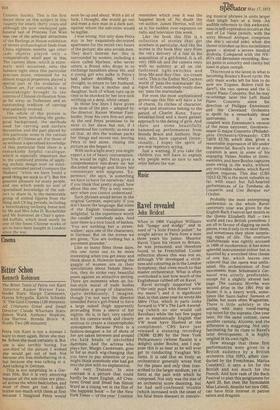Art
Shakers and jade
Ernie Money
The Shakers were a Quaker-type sect who emigrated from England to America in 1774, in the persons of Ann Lee, daughter of a Manchester blacksmith, and six of her followers. Their theology was unusual, to say the least, since they believed in the dual nature of God, both male and female, which had manifested itself through the prophetic agencies of Jesus Christ and 'Mother' Ann Lee herself.
The Shaker aesthetic principles were all based on the search for perfection and a joyous dedication to God's purpose. "Anything may with strict propriety be called perfect," ran one of their maxims, "if it perfectly answers the purpose for which it was designed." Beauty rested therefore on utility, regularity, order and simplicity. All functional design was dedicated to attaining the highest suitability. the Shakers to achieve extraordinarily beautiful levels of simplified design in their architecture, their furniture and their other artifacts but have given them a lasting impact in some surprising places. Either directly or unconsciously, their work has influenced a wide selection of subsequent artistic innovators, including, in one way or another Michael Thonet, the progenitor of hentwood furniture, Otro Wagner, Charles Rennie Mackintosh and Mies van der Rohe, to name only a few. The great Chicago architect, Louis Sullivan's saying, "form follows function," was a projection of an earlier Shaker precept, "every force evolves a form." Their principle of beauty following order laid down guide lines which are still of considerable consequence. "We find out by trial and error what is best, and when we have found a good thing we stick to it," another maxim claimed, "All beauty that has not a foundation in use soon grows distasteful and needs constant replacement with something new."
With the subsequent association of some of these ideas with certain of the Bauhaus artists it is hardly surprising that the Shaker artistic ideals have been widely studied in present-day Germany and Austria. The current exhibition of Shaker art at the Victoria and Albert Museum (until June 15) has been instigated by the distinguished Viennese architect Dr Karl Mang, president of the Austrian Institute of Design, and Dr Wend Fischer, director of the Neue Sammlung at Munich, in which city it was first seen. As the latter says in an introduction to its catalogue, we need "to ponder their way of life and concept of design, as we observe our own way of life with increasing concern and scepticism, and wonder what quality of life we hope to achieve by it."
The 61joyment of this exhibition can therefore be taken at a double level. One is the relevance of the Shakers' concepts to the increasingly burdensome and self-inflicted problems of reconciling our own way of life with the disadvantages of an industrial environment. The other is a sheer pleasure at the largely unfamiliar selection of their objects on view, particularly the chairs, tables and fabrics and the excellent photographs of their buildings. For those who want to see what a Shaker room looked like as a whole there is a good example in the American Museum at Bath.
Also at the V. and A. (until June 22) there is an important exhibition of Chinese Jade through the agPs, which has been organised h% the Arts Council and the Oriental
Ceramic Society. This is the first major show on this subject in this country for nearly thirty years and although the now celebrated jade funeral suit of Princess Ton Wan was one of the principal attractions of the Burlingtm House exhibition of recent archaeological finds from China eighteen months ago other jade objects played only a comparatively small part in this. The current show, which is extremely well mounted, sets the balance right since this particular precious stone, venerated for its almost magical properties, played a special part in the evolution of Chinese art. For centuries it was painstakingly brought to the centres of Chinese civilisation from as far away as Turkestan and an Outstanding tradition of carving was patiently evolved.
The whole of this process is covered here, including the geological background, the methods used for carving and surface decoration and the part played by this particular stone in the various periods of Chinese art. For those of us without a specialised knowledge of this particular field there is a remarkably helpful catalogue, which is especially important due to the continued process of applying archaic design over an extremely extended period (compare the Shakers' "when we have found a good thing we stick to it"). But the greatest pleasure for many people, and one which needs no sort of specialised knowledge of the subject to share in, is the memorable group of animal figures from the Ming and Ch'ing periods, including a breathtaking reclining horse lent by Mr and Mrs John D. Rockefeller and Mr Somerset de Chair's splendid buffalo, which must surely be one of the finest Chinese works of art to have been bought in London since the war.



























 Previous page
Previous page